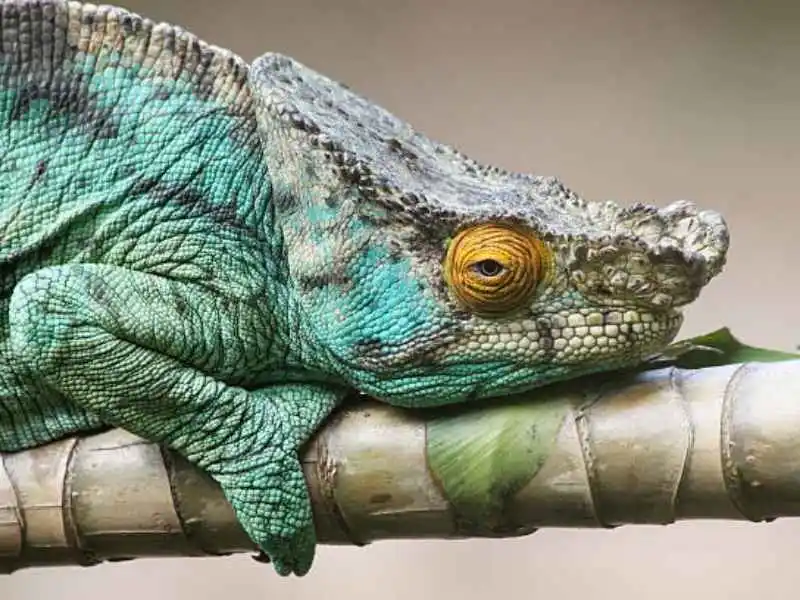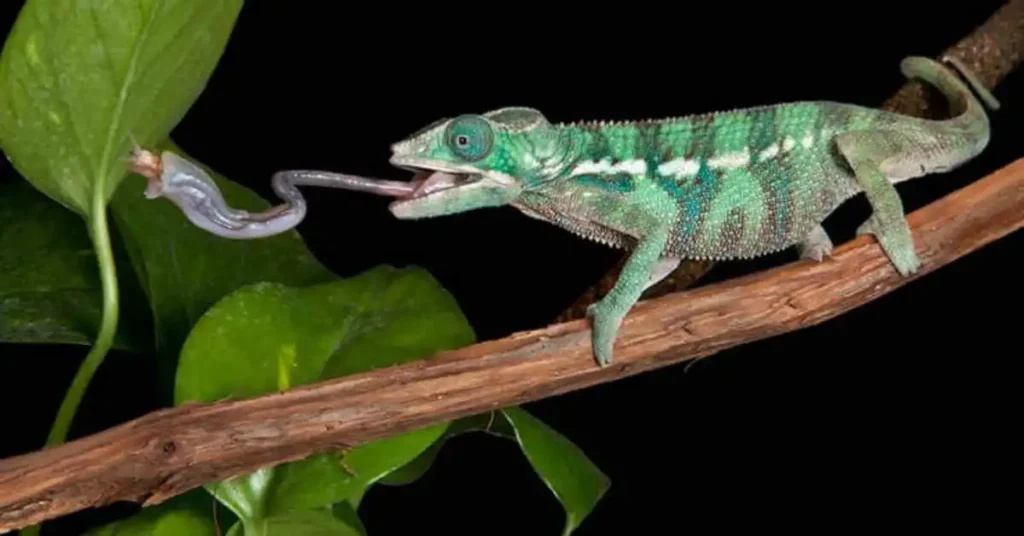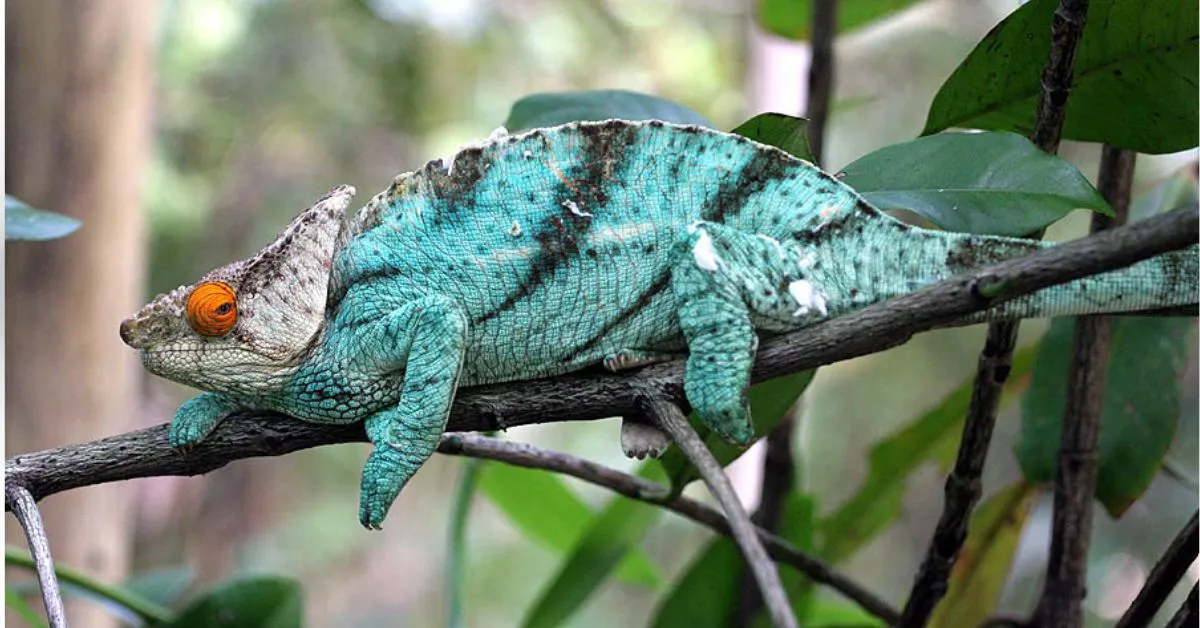Parson’s Chameleon Profile Guide
Parson’s chameleon is mostly native to eastern and northern Madagascar. Occurs from lowlands to 1195 meters, predominantly in moist primary forest but may also inhabit some disturbed areas with trees. They have a natural habit of rotating their eyes in every direction and their vibrant color looks very attractive and unique. They are unique pets due to their calm and cool behavior.
Physical Appearance of Parson’s Chameleon:
Male Parson’s Chameleons have ridges from above their eyes to their nose that form two wart-like horns. Many color varieties are found within its range. These include the orange eye also known as the white lip (generally considered characteristic of the organic subspecies) in which the male is relatively small and mostly green or bluish but has yellow or orange eyelids.
In “yellow lip the male is slightly larger and mostly green or blue, but yellow on the edge of the mouth; In the “Yellow Giant” the male is very large and yellowish in color overall (shows dark markings when stressed); And in “Green Giant” the male is green overall. C. p. Cristifer males are generally green or bluish. Females of both subspecies are smaller than males and generally green, yellow, or brown (often with an orange admixture).

Food and Diet of Parson’s Chameleon:
Parson’s chameleons feed primarily on invertebrates, especially insects, but are also opportunistic and will occasionally eat small vertebrates such as lizards and small birds. It is a sedentary predator that is generally slow-moving and fairly inactive (most active during the breeding season).
There are a few anecdotal reports of eating plant matter such as leaves, flowers, and pollen, which is unusual for chameleons but not unique (plant diets in other species, such as the Malagasy giant, Namaqua, and valeric chameleon) have been proven.

Parson’s Chameleon Behavior:
The Parson’s chameleon is a tree-dwelling, or arboreal, species that tends to be solitary. It would rather live high up on branches for most of its life. He is walking at a really slow, focused pace; it feels as though he’s inhaling each step made. This is exactly in the same manner most leaves and staffs from branches move when a gust of wind blows which makes it easier to blend with their surroundings and hence does not attract unwanted attention by potential predators. Such a maneuver exposes it to part of the leaves in the natural environment, which increases its protection.
Natural Habitat of Parson’s Chameleon:
The local habitat of the Parsons chameleon is the moist forests of Madagascar, situated in the eastern highlands (maximum elevation up to 2134 m), but it can also be found in lowlands and seaside areas. The seaside lowlands and upland (forest canopy) regions are humid and warm throughout the year, with an average temperature of 27 to 32 degrees Celsius. Chameleons usually live in hot and humid environments but can bear the cool temperatures of Madagascar. The average temperature throughout the year in the eastern region of Madagascar is usually between 20 and 28 degrees Celsius. Annual rainfall in their habitat can be up to 381 cm. This creature is widely found in the rainforests of Madagascar.
Why Are These Parson’s Chameleons Special as Pets?
Parsons chameleons are sometimes purchased as pets. This species is of particular interest to reptile enthusiasts. Its popularity in the pet trade is increasing, although the hobby of keeping Parsons’ chameleons poses a challenge to the average reptile owner. Chameleons are expensive to keep, but Parson’s chameleons require extra labor, food, confinement, and space due to their large size.
Habitat and Housing Needs of Parson’s Chameleons:
Size of Enclosure:
Cages should be appropriate to the size of their body, so they can live comfortably and grow big. An adult enclosure should be a minimum of 18(l) x 18(w) x 36(h). If you raise the enclosure area then their cage size is 24(l) x 24 (w) x 48(h).
Temperature and Lighting:
For them to accomplish this their enclosures absolutely must have basking sites, and cool zones in which temperature can be maintained. Basking lamps are used to provide their calcium deficiency as well as OVB light and temperature. This brought better-looking bones/joints caused by UVB Light. They usually require a temperature around 70 to 80 F in basking areas and about the normal of 65-70F during night time.
Humidity:
They require humidity to be proper in the habitat. If the humidity level is not at normal they can keep dehydrating, so mist them every day to prevent dehydration.
Substrate:
It needs a large amount of substrate in the enclosure as it helps to maintain a normal humidity level. These recommendations also apply to children and should be kept in a simple substrate such as reptile carpet or clay-free soil. Do not cultivate your reptile in the sand and bark substrate, as for them it is a desert forest.
Lifespan of Parson’s Chameleons:
The Parsons chameleon is one of the longest-lived species of chameleon. Wild male chameleons are known to live to be at least 9 years old, while female chameleons live to be at least 8 years old; It is estimated that its lifespan in the wild is 10 to 12 years. In captivity, it has been recorded to live up to 14 years, longer than any other chameleon species confirmed, and some Parson’s chameleons may be capable of living up to 20 years.
Breeding of Parson’s Chameleons:
Polygynous (one male mate with multiple females) for the treatment being given. Breeding season is May -October. While in captivity, females can lay over fifty eggs at a time and those 2 year gestation periods will incubate for another two years. For example, a single healthy young hatched from an egg 781 days later. Should clarify that females lay eggs every two years.
The cycle of females is once every 2years. They reach independence as soon as they leave an underground nest built by their parents. After the nest is dug, eggs are laid and buried there — a female’s job as a parent is done. Parents do not help with any type of child care. Most of the species are sexually mature by 3-years.
Common Health Problems of Parson’s Chameleons:
Respiratory Problems:
Due to poor ventilation, low humidity, and high or low temperature, they begin wheezing, taking a breath by opening the mouth along with lethargy showing respiratory issues. This can be prevented by controlling the humidity and adding ventilation to the terrarium, as well as diagnosing the medical issue.
Eye Problems:
Swelling around the eyes is indicative to a very poor humidity level in the enclosure(and condition), causing swallowing. If you want to avoid this, improve the conditions of their enclosure and keep up with good humidity levels.
Caring Tips of Parson’s Chameleons:
Parson’s Chameleons are considered one of the trickiest little lizards to care for, but if you’re willing to invest some money in the initial setup and time for ongoing care and maintenance, they can be a great and very enjoyable species. However, they are generally not tolerant of holding and handling. Some chameleons can tolerate being picked up, but they will not enjoy the experience and prefer to be left alone, to be watched from a distance. If you’re looking for a pet that you can pick up and handle, perhaps consider another lizard.
Price and Cost of Parson’s Chameleon:
Parsons chameleon, due to its rarity and specific care requirements, is usually more expensive. Although age and size affect price, a Parson’s chameleon typically costs $300 to $800 or more, especially for mature chameleons.
A more detailed price breakdown for Parson’s Chameleon is:
- Hatchlings: Usually $300 to $500
- Minors: Often $400 to $700Adults: Usually $600 to $1,000 or more
Conclusion:
Parsons chameleon is mainly found in South Africa. They are unique due to their bright color and attractive look. Their calm demeanor with their owner is also special. They generally prefer to be alone. This article provides you with all the essential information about it, and we expect it will be useful for you.







